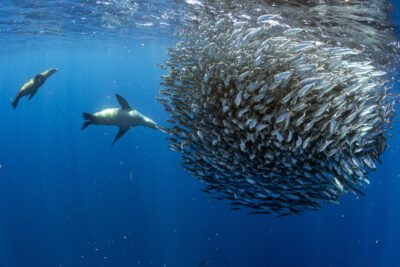Pacific Sardines

Pacific sardines are a major forage species in the California Current Ecosystem that can range from British Columbia to Baja California. Feeding primarily on plankton, they play a critical role in transferring energy from low to higher trophic levels. Many marine mammals, fish, and seabirds rely on Pacific sardines as a large part of their diet. These small fish have extended periods of booms and busts associated with oceanic conditions. While the population naturally declines in response to changing oceanographic conditions, fishing can have a dramatic effect on sardine population dynamics and its ability to provide forage for predators. When sardines are at low abundances or in low productivity conditions, fishing pressure exacerbates the population decline, makes sardines less available for predators, and harms the ability of the population to recover when conditions become more favorable.
In the 1930s and 1940s Pacific sardines supported the largest fishery in the western hemisphere. The iconic “Cannery Row” in Monterey, California was built around this ballooning fishery. In 1936 the Pacific sardine fishery peaked at 800,000 metric tons, followed by a dramatic fishery collapse in the 1950’s due to a combination of fishing pressure and poor ocean conditions. It did not begin to recover until the 1980s, and never returned to the levels seen in the Cannery Row era.
The Pacific sardine fishery off California, Oregon and Washington is managed by federal fishery managers under the “Coastal Pelagic Species Fishery Management Plan” pursuant to the nation’s fishery management law; the Magnuson-Stevens Fishery Conservation and Management Act. Rather than learning from the mistakes of the past collapse, there remain major flaws with how sardines are managed.
Beginning in 2006 the Pacific sardine population began declining again. Fishery managers ignored their own scientists’ 2012 prediction that the population would collapse due to ocean conditions and excessive fishing pressure. In response to an emergency petition by Oceana, federal fishery managers closed the directed fishery in 2015. However, they continued to allow directed fishing for bait and incidentally when targeting other forage fish. In 2019, the National Marine Fisheries Service declared the population overfished, but then adopted a rebuilding plan in 2021 setting excessive catch limits that their own analysis indicated would fail to rebuild the population in the required timeframe, if at all. In response, Oceana and Earthjustice filed litigation challenging the rebuilding plan which is currently ongoing. The 2022 subpopulation assessment indicated the population has declined by 98% since 2006 and is not recovering. Until the subpopulation recovers, catch limits should be set far lower. In the future, the cutoff – the minimum population size to allow for commercial fishing – should be set far higher to prevent the fishery from exacerbating future collapses and help ensure that dependent predators like sea lions and brown pelicans will be able to find enough food.
Commercial fisheries in the U.S., Canada, and Mexico each target the same subpopulation of sardines and there is no coordinated management program. Scientists currently recognize two geographically separate subpopulations of sardines in U.S. waters – known as the northern and southern subpopulations. These subpopulations migrate across the international border between the U.S. and Mexico, and the northern subpopulation sometimes migrates into British Columbia. Currently the U.S. only assesses and manages the northern subpopulation, however, allows fishing on the southern subpopulation. The. U.S. should add the southern subpopulation to its Coastal Pelagic Species Fishery Management Plan, assess both the northern and southern subpopulations, and set catch limits for both subpopulations. Achieving a common scientific understanding of the population status and distribution across the three nations could serve as the basis for coordinated and sustainable tri-national sardine management.



